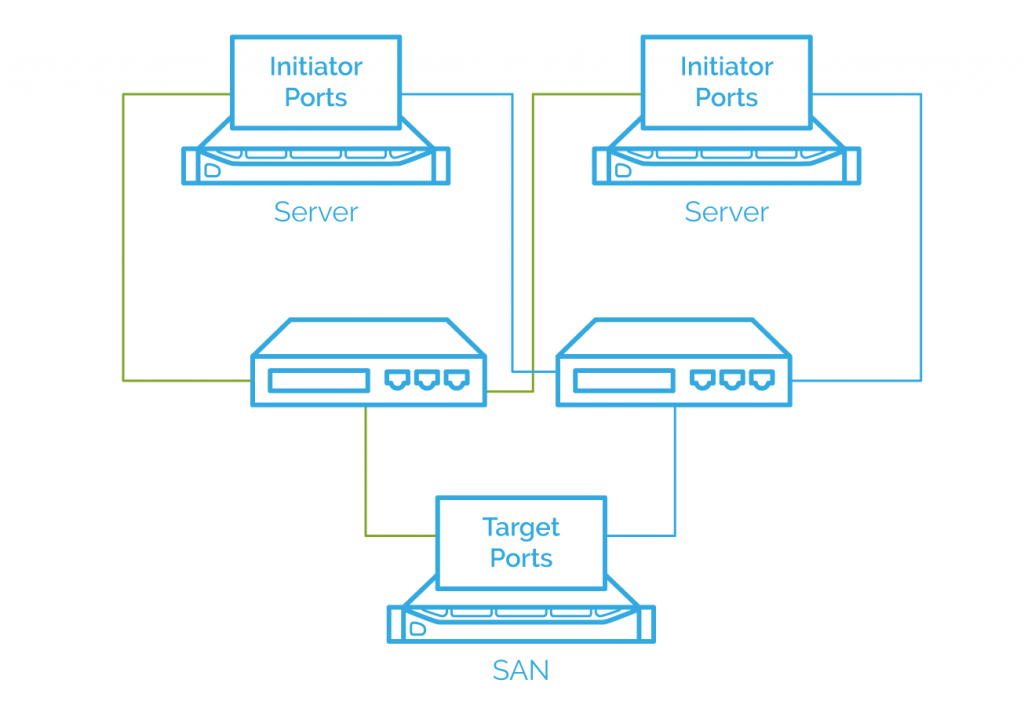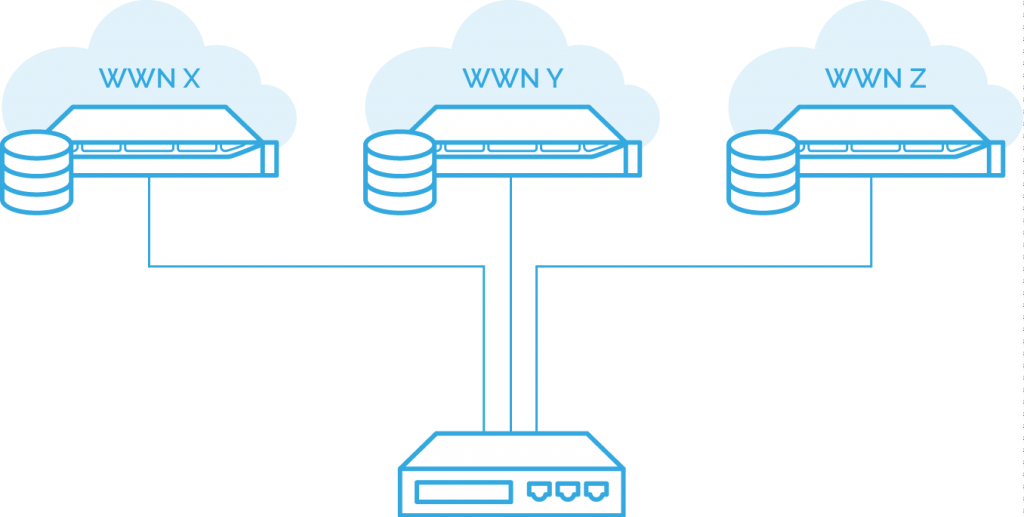Introduction
This article is intended to introduce you to the main concepts and features of Fibre Channel (FC), the high-speed network technology and a relevant family of standards (protocols) for storage networking that was standardized in 1994.
FC is one of the first technologies used for connecting data storage to servers, for example, in Storage Area Networks (SAN). On the physical layer, it is typically built with optical fiber cables. There are three major Fibre Channel topologies: Point-to-Point, Arbitrated Loop, and Switched Fabric. FC is available at 1, 2, 4, 8, 10, 16, 32 and 128 Gbit/s speeds.
Fibre Channel is really hard to match for its low latency and high throughput because it was designed specifically to handle storage traffic. With Fibre Channel protocol (FCP) the frames are processed solely by dedicated low-latency host bus adapters (HBA), which allow the server’s CPU to focus on handling applications. The protocol is simple and single-purpose, so switching latency is considerably low. FCP also includes a built-in mechanism of flow control which ensures the readiness of the target device to receive data.
The main drawback of FC is its cost: it demanded special dedicated switches and host bus adapters, and there was no efficient way to support remotely located units. Also, managing FC demands from a system administrator specific skill set and experience.
That is why, same as Fibre Channel originally replaced the Small Computer System Interface (SCSI), at some point, it was challenged by newly emerging iSCSI technology. Later, in order to allow Fibre Channel to use high-speed Ethernet networks while preserving the Fibre Channel protocol, the Fibre Channel over IP (FCIP) and Fibre Channel over Ethernet (FCoE) technologies were introduced.
FCoE uses standard Ethernet networks to connect servers with storage. It operates directly above Ethernet in the network protocol stack, which leads to lower latency as TCP/IP header does not have to be handled. On the other hand, it cannot be routed over a TCP/IP World Area Network (WAN), only Local Area Network (LAN) can be used, whereas connecting to a remote fabric will require a bridge.
Using FCoE is primarily beneficial when it is used as an extension of an already existing Fibre Channel network, as FCoE can use the same management tools as FC, and much of the experience gained in operating an FC fabric can be applied to its configuration and maintenance.
FC Structure
Both traditional Fibre Channel (FC) and the newer Fibre-Channel-over-Ethernet (FCoE) infrastructure consist of these typical components:
Fabric – a network which contains one or more Fibre Channel switches.
WWN (World Wide Name) – a port identifier, a close analog to a MAC address. Has the length of 64 bits.
Initiator – a device exploiting the storage, in most of the cases, a server, which starts a connection over the fabric to one or more targets.
HBA (Host Bus Adapter) – a circuit board and/or integrated circuit adapter that maintains I/O processing and physical connectivity between a host and a storage and/or network device.
Target – a port on a storage system which delivers storage volumes (AKA target devices or LUNs) to the initiators.
Zone – a part of Fabric where devices are allowed to communicate to each other.
The Purpose of Zoning
Initiators are put into zones in order to keep them from communicating with all the targets on a fabric. A zone can be just a list of WWNs containing an initiator WWN and one or more target WWNs. Zones also may be united into zone sets or zoning configs for easier roll-out and management.
Basically, a zone set is a group entity for the individual zones, that are supposed to work together. It can contain WWN zones, port zones, or a combination of both (hybrid zones). There may be many zone sets in a fabric but the only one can be active at a time.
There are two main methods of zoning: soft and hard.
Soft zoning: The fabric naming service shows an initiator only the names of devices it is allowed to connect to, but the initiator still can try to contact any device on the network by address. Less secure, but lower demands to the equipment. All modern Storage Area Network (SAN) switches enforce soft zoning in hardware.
Hard zoning: actual communication is restricted across a fabric. More secure, but demands relevant hardware solution, e.g. frame filtering.
Port and WWN zoning
When the port based zoning is used, traffic circulation is restricted based on the specific switch port the device is connected to. If the device gets relocated, that will reject its access, whereas a different device connected to the same port will gain access to any resources the previous host had access to.
WWN zoning, or name zoning, restricts access by a device’s WWN. In this case, the host access does not rely on the port it is plugged into, and its permissions will not be granted to another device using its previous location.
Zone alias
So, what can be done in order to facilitate referring to devices in a fabric? Their WWN should be substituted with zone aliases.
For example, if several target port WWNs are grouped together into one zone alias, it may look something like:
targ-au-meyfs01 { 90:aa:00:16:df:11:ae:01, 90:aa:00:84:13:ff:ff:15 }
Then, a zone consisting of this target group and an initiator init-au-meyfs01 will look like:
zone1-meyfs01 {targ-au-meyfs01 , init-au-meyfs01}
Conclusion
We have gone through the basics of Fibre Channel concepts and configuration including what is called WWN zoning that allows you plugging in your cables into any port needed to be opposed to port zoning. It does not matter which kind or vendor of hardware you are configuring since all the terms mentioned above are standard worked out by SNIA a long time ago.




